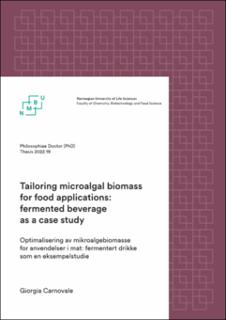| dc.contributor.advisor | Horn, Svein Jarle | |
| dc.contributor.advisor | Skjånes, Kari | |
| dc.contributor.advisor | Barbosa, Maria | |
| dc.contributor.advisor | Wicklund, Trude | |
| dc.contributor.author | Carnovale, Giorgia | |
| dc.date.accessioned | 2022-08-02T10:20:06Z | |
| dc.date.available | 2022-08-02T10:20:06Z | |
| dc.date.issued | 2022 | |
| dc.identifier.isbn | 978-82-575-1894-3 | |
| dc.identifier.issn | 1894-6402 | |
| dc.identifier.uri | https://hdl.handle.net/11250/3009753 | |
| dc.description.abstract | Microalgae are renowned as super-foods due to their unique nutritional profiles; however, their applications to human nutrition are still limited to nutraceuticals and food supplements. This is likely due to factors such as high production costs, the complexity of product development, and their impact on the technical and sensory properties of different foods. Producing algal biomass tailored to fit into established
production processes is a possible way to tackle all of these issues, expanding the microalgal industry and leading to novel discoveries and improvements in sustainability.
This thesis discusses a holistic approach to tailoring microalgal biomass for application in novel products, providing an overview of the current status of microalgal food research and the related challenges, followed by a discussion of possible approaches to enhance biomass composition.
The three papers/ manuscripts included in this thesis explore the whole process leading to the development of a novel beverage for human consumption, producing microalgal starch-rich biomass and applying it as an active ingredient in beer brewing. In the first work, starch production in the freshwater species Chlorella vulgaris was studied using High Throughput FTIR spectroscopy to screen for optimal
environmental and nutrient conditions on an extensive experimental design. Selected conditions were further tested in a flat panel reactor to assess the role of light through biomass specific photon supply rate, finally achieving a maximum starch concentration of up to 50% of the dry weight in up-scaled 25 L tubular
photobioreactors. The second manuscript studied the starch metabolic pathways connected to nitrogen stress and recovery on salt-water species Tetraselmis chui, giving an overview of gene expression analysis during accumulation and subsequent degradation of 60% starch. Finally, the application of starch as an active ingredient was tested in brewing. Starch-rich biomass was developed in a 250 L pilot-scale
photobioreactor, following indications from the first two papers, and brewing was successfully performed with support from an industrial partner, the Norwegianbased craft brewery Nøgne Ø.
Based on the experiments presented in the current thesis, the production of biomass tailored to a target product proved to be an efficient method to successfully implement microalgae in established food products. | en_US |
| dc.description.abstract | Mikroalger er kjent som ’supermat’ på grunn av høyt næringsinnhold, men innen human ernæring er bruken av mikroalger fortsatt begrenset til nutraceuticals og kosttilskudd. Dette skyldes sannsynligvis en kombinasjon av faktorer, som høye produksjonskostnader, kompleksitet i produktutvikling og innvirkning på de tekniske og sensoriske egenskapene til ulike matvarer. Å produsere algebiomasse som er skreddersydd for å passe inn i etablerte produksjonsprosesser har potensiale til å takle alle disse problemene, og dermed føre til en ekspansjon av mikroalgeindustrien, nye oppdagelser og forbedringer i bærekraft. Denne oppgaven diskuterer en helhetlig tilnærming for å skreddersy mikroalgebiomasse for bruk i nye produkter, og gir en oversikt over dagens status innen forskning på mikroalgemat og relaterte utfordringer, etterfulgt av en diskusjon av mulige tilnærminger for forbedring av biomassekomposisjonen. De tre artiklene/manuskriptene som er inkludert i denne oppgaven, utforsker hele prosessen som fører til utviklingen av en ny drikk for humant konsum. I prosessen blir stivelsesrik algebiomasse produsert og brukt som en aktiv ingrediens i ølbrygging. I det første arbeidet ble stivelsesproduksjonen i ferskvannsarten Chlorella vulgaris studert ved bruk av HT-FTIR spektroskopi for å screene for optimale miljø- og næringsbetingelser i et stort eksperimentelt design. Utvalgte dyrkingsbetingelser ble videre testet i flatpanelreaktorer for å vurdere lysets rolle gjennom biomassespesifikk fotontilførsel for til slutt å oppnå en maksimal stivelseskonsentrasjon på opptil 50 % av tørrvekten i oppskalerte 25 L rørbaserte fotobioreaktorer. Metabolismeveiene for stivelse som er knyttet til nitrogenstress og stressrestitusjon, ble studert i saltvannsarten Tetraselmis chui, og manuskript nummer to presenterer resultater fra genekspresjonsanalyse ved akkumulering og nedbrytning av 60 % stivelse. Til slutt ble bruken av stivelse som aktiv ingrediens testet i brygging. Utviklingen av stivelsesrik biomasse ble utført i en 250 L pilotskala fotobioreaktor, etter indikasjoner fra de to første arbeidene, og bryggingen ble vellykket utført med støtte fra en industriell partner, det norske håndtverksbryggeriet Nøgne Ø. Resultatene presentert i denne avhandlingen, viste at produksjon av mikroalgebiomasse med komposisjon tilpasset et spesifikt målprodukt, kan være en effektiv metode for å lykkes med implementering av mikroalger i etablerte matprodukter. | en_US |
| dc.language.iso | eng | en_US |
| dc.publisher | Norwegian University of Life Sciences, Ås | en_US |
| dc.relation.ispartofseries | PhD Thesis;2022:19 | |
| dc.rights | Attribution-NonCommercial-NoDerivatives 4.0 Internasjonal | * |
| dc.rights | Attribution-NonCommercial-NoDerivatives 4.0 Internasjonal | * |
| dc.rights | Attribution-NonCommercial-NoDerivatives 4.0 Internasjonal | * |
| dc.rights.uri | http://creativecommons.org/licenses/by-nc-nd/4.0/deed.no | * |
| dc.subject | food | en_US |
| dc.subject | starch | en_US |
| dc.subject | brewing | en_US |
| dc.subject | Chlorella vulgaris | en_US |
| dc.subject | Tetraselmis chui | en_US |
| dc.subject | microalgae | en_US |
| dc.subject | biotechnology | en_US |
| dc.subject | stress | en_US |
| dc.subject | starch metabolism | en_US |
| dc.title | Tailoring microalgal biomass for food applications : fermented beverage as a case study | en_US |
| dc.title.alternative | Optimalisering av mikroalgebiomasse for anvendelser i mat : fermentert drikke som en eksempelstudie | en_US |
| dc.type | Doctoral thesis | en_US |
| dc.relation.project | NordForsk: 82845 | en_US |
| dc.relation.project | Norges forskningsråd: 267872 | en_US |

